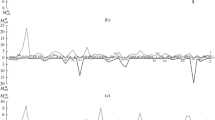Summary
Aerosol particles have been separated by filter at a mountain station at 1780 m a.s.l. continuously since 1972. The station (a WMO-BAPMoN station with extended program) is freely exposed to all sides and in no way influenced by local aerosol sources. In the cold seasons it lies almost exclusively above the convection layer (very often over inversions) so that real background data can be acquired in these cases. By means of analytical methods the chemical components are determined on the exposed filters. This includes (apart from crust elements) also cations and anions from man-made and maritime sources as well as some important trace elements (in all, 15 components). Filters are exposed over 1–4 days. Filter exchange is determined by the respective weather situation with due regard to all changes so that the requirements for a reasonable correlation of the measured values with the meteorological conditions are met. Additionally, all meteorological parameters are determined, as well as intensity of the vertical exchange, number density of Aitken nuclei, concentration of natural radioactivity (RaB), and other variables. In the present paper the components of the aerosol chemical matrix are related to the behavior of the parameters below and the results are discussed in detail: Dependence of the individual components on total aerosol mass per volume, type of air mass; representation of two single cases of long-range transport of crust elements (source areas: Sahara, Colorado); vertical exchange coefficient, concentration of natural radioactivity, temperature gradient between valley and mountain station, temperature at the sampling site, relative humidity, precipitation rate, wind direction. occurrence of fog.
Zusammenfassung
An einer allseitig frei exponierten Bergstation in 1780 m NN werden seit 1982 die Aerosolpartikel auf Filtern gesammelt. Die Station (eine WMO-BAPMoN-Station mit erweitertem Programm) wird nicht durch lokale Aerosolquellen in irgendeiner Weise beeinflußt. Sie liegt in den kalten Jahreszeiten fast ausschließlich über der Konvektionsschicht (sehr oft oberhalb von Inversionen), so daß in diesen Fällen echte Background-Daten erfaßt werden. Mittels analytischer Verfahren werden an den exponierten Filtern alle chemischen Hauptkomponenten (von den Krustenelementen abgesehen auch die Kationen und Anionen sowohl anthropogenen als auch maritimen Ursprungs), sowie einige gewichtige Spurenelemente (insgesamt 15 Komponenten) bestimmt. Die Filter werden 1–4 Tage lang exponiert. Der Filterwechsel wird durch den jeweiligen Wetterzustand bzw. seiner Veränderung gesteuert, so daß eine gute Voraussetzung für eine Zuordnung der Meßwerte zu den meteorologischen Bedingungen gegeben ist. Zusätzlich werden alle meteorologischen Parameter, sowie die Intensität des Vertikalaustausches, Zahl der Aitken-Kerne, Konzentration der natürlichen Radioaktivität (RaB) und andere Größen bestimmt. In der vorliegenden Arbeit werden die Komponenten der chemischen Aerosolmatrix zum Verhalten der folgenden Parameter in Beziehung gesetzt und die Ergebnisse eingehend diskutiert:
Abhängigkeit der Einzelkomponenten von: Gesamt-Aerosohnasse pro Volumen; Typ der Luftmasse und Darstellung von zwei Einzelfällen eines Ferntransportes von Krustenelementen (Quellgebiete: Sahara, Colorado); vertikaler Austauschkoeffizient; Konzentration der natürlichen Radioaktivität; Temperaturgradient zwischen Tal- und Bergstation; Temperatur an der Probennahmestelle; relative Feuchte; Niederschlagsintensität; Windrichtung; Auftreten von Nebel.
Similar content being viewed by others
References
Reiter, R., Pötzl, K., Sladkovic, R.: Determination of the Concentration of Chemical Main and Trace Elements (Chemical Matrix) in the Aerosol from 1972 to 1982 at a North-Alpine Pure Air Mountain Station at 1780 m a.s.l. Part 1: Methods of Measurement, Total Concentrations, Families of Elements, Annual Variations, Trend Analysis. Arch. Met. Geoph. Biocl., Ser. B34, 215–241 (1984).
Taylor, S. R.: Abundance of Elements in the Continental Crust: a New Table. Geochim. Cosmochim. Acta28, 1273–1285 (1964).
Rahn, K. A., Lowenthal, D. H.: Elemental Tracers of Distant Regional Pollution Aerosols. Science228, 132–139 (1984).
Reiter, R., Carnuth, W., Sladkovic, R.: Effects of Atmospheric Fine Structure Characteristics on the Vertical Distribution of Aerosols. Arch. Met. Geoph. Biokl., Ser. A17, 336–365 (1968).
Reiter, R., Sladkovic, R., Camuth, W.: On Fine Structure and Control of Vertical Aerosol Exchange between 700 and 3000 m, New Methods and Results. Arch. Met. Geoph. Biokl., Ser. A20, 115–157 (1971).
Hegg, D. A., Hobbs, P. V.: Measurements of Sulfate Production in Natural Clouds. Atmos. Environm.16, 2663–2668 (1982).
Okada, K.: Nature of Individual Hygroscopic Particles in the Urban Atmosphere. J. Met. Soc. Japan61, 727–746 (1983).
Okada, K., Kobayashi, A., Kiba, N., Iwasaka, Y., Takeda, T.: On the Number Size Distribution of Aitken Particles in the Urban Atmosphere — With Regard to Sulfate Particles. J. Met. Soc. Japan61, 737–745 (1983).
Author information
Authors and Affiliations
Rights and permissions
About this article
Cite this article
Reiter, R., Pötzl, K. & Sladkovic, R. Determination of the concentration of chemical main and trace elements (chemical matrix) in the aerosol from 1972 to 1982 at a North-alpine pure air station at 1780 m a.s.l.. Arch. Met. Geoph. Biocl., Ser. B 35, 1–30 (1984). https://doi.org/10.1007/BF02269406
Received:
Published:
Issue Date:
DOI: https://doi.org/10.1007/BF02269406



